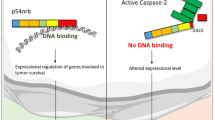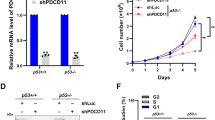Abstract
The glycoprotein clusterin (CLU), has two known isoforms generated in human cells. A nuclear form of CLU protein (nCLU) is pro-apoptotic, while a secretory form (sCLU) is pro-survival. Both forms are implicated in various cell functions, including DNA repair, cell cycle regulation, and apoptotic cell death. CLU expression has been associated with tumorigenesis and the progression of various malignancies. In response to DNA damage, cell survival can be enhanced by activation of DNA repair mechanisms, while simultaneously stimulating energy-expensive cell cycle checkpoints that delay the cell cycle progression to allow more time for DNA repair. This review summarizes our current understanding of the role of clusterin in DNA repair, apoptosis, and cell cycle control and the relevance.


Similar content being viewed by others
References
Berardi P, Russell M, El-Osta A et al (2004) Functional links between transcription and apoptosis. Cell Mol Life Sci 61:2173–2180
Bettuzzi S, Scorcioni F, Astancolle S et al (2002) Clusterin (SGP-2) transient overexpression decreases proliferation rate of SV40-immortalized human prostate epithelial cells by slowing down cell cycle progression. Oncogene 21:4328–4334
Cervellera M, Raschella G, Santilli G et al (2000) Direct transactivation of the antiapoptotic gene apolipoprotein J (clusterin) by B-MYB. J Biol Chem 275:21055–21060
Chen TY, Chen JS, Su WC et al (2005) Expression of DNA repair gene ku80 in lymphoid neoplasm. Eur J Haematol 74:481–488
Chow TY, Choudhury SA (2005) DNA repair protein: endo-exonuclease as a new frontier in cancer therapy. Future Oncol 1:265–271
Criswell T, Klokov D, Beman M, Lavik JP, Boothman DA (2003) Repression of IR-inducible clusterin expression by the p53 tumour suppressor protein. Cancer Biol Ther 2:372–380
Criswell T, Beman M, Araki S, Leskov K, Cataldo E, Mayp LD, Boothman DA (2005) Delayed activation of insulin-like growth factor-1 receptor/SrcMAPK/Egr-1 signaling regulates clusterin expression, a pro-survival factor. J Biol Chem 280:14212–14221
Gleave M, Miyake H (2005) Use of antisense oligonucleotides targeting the cytoprotective gene, clusterin, to enhance androgen- and chemo-sensitivity in prostate cancer. World J Urol 23:38–46
Gleave M, Miyake H, Chi K (2005) Beyond simple castration: targeting the molecular basis of treatment resistance in advanced prostate cancer. Cancer Chemother Pharmacol 56:47–57
Gleave M, Nelson C, Chi K (2003) Antisense targets to enhance hormone and cytotoxic therapies in advanced prostate cancer. Curr Drug Targets 4:209–221
Hara I, Miyake H, Gleave ME et al (2001) Introduction of clusterin gene into human renal cell carcinoma cells enhances their resistance to cytotoxic chemotherapy through inhibition of apoptosis both in vitro and in vivo. Jpn J Cancer Res 92:1220–1224
July LV, Beraldi E, So A, Fazil L et al (2004) Nucleotide-based therapies targeting clusterin chemosensitized human lung adenocarcinoma cells both in vitro and in vivo. Mol Cancer Ther 3:223–232
Lakins J, Bennett SA, Chen JH et al (1998) Clusterin biogenesis is altered during apoptosis in the regressing rat ventral prostate. J Biol Chem 273:27887–27895
Leskov K, Criswell T, Antonino S et al (2001) When X-ray-inducible proteins meet DNA double strand break repair. Semin Radiat Oncol 11:352–372
Leskov K, Klokov D, Li J et al (2003) Synthesis functional analyses of nuclear clusterin, a cell death protein. J Biol Chem 278:11590–11600
Li L, Zou L (2005) Sensing, signaling, and responding to DNA damage: organization of the checkpoint pathways in mammalian cells. J Cell Biochem 1:298–306
Miyake H, Nelson C, Rennie PS et al (2000) Testosterone-repressed prostate message-2 is an antiapoptotic agent involved in progression to androgen independence in prostate cancer. Cancer Res 60:170–176
Miyake H, Hara I, Kamidono S et al (2001) Synergistic chemosensitization and inhibition of tumor growth and metastasis by the antisense oligonucleotides targeting clusterin gene in a human bladder cancer model. Clin Cancer Res 7:4245–4252
Miyake H, Hara I, Kamidono S et al (2003) Resistance to cytotoxic chemotherapy induced apoptosis in human prostate cancer cells is associated with intracellular clusterin expression. Oncol Rep 10:469–473
Miyake H, Hara I, Gleave ME et al (2004) Protection of androgen-dependent human prostate cancer cells from oxidative stress-induced DNA damage by overexpression of clusterin and its modulation by androgen. Prostate 61:318–323
Montpetit ML, Lawless KR, Tenniswood M (1986) Androgen-repressed messages in the rat ventral prostate. Prostate 8:25–36
Osborne JE, Hutchinson PE (2002) Vitamin D and systemic cancer: is this relevant to malignant melanoma? Br J Dermatol 147:197–213
Pajak B, Orzechowski A (2006) Clusterin: the missing link in the calcium-dependent resistance of cancer cells to apopogenic stimuli. Postepy Hig Med Dosw 60:45–51
Pucci S, Bonnano E, Pichiorri F et al (2004) Modulation of different clusterin isoforms in human colon tumorigenesis. Oncogene 23:2298–2304
Shah MA, Schwartz GK (2003) Cyclin-dependent kinases as targets for cancer therapy. Cancer Chemother Biol Response Modif 21:145–170
Shannan B, Seifert M, Leskov K et al (2006) Challenge and promise: roles for clusterin in pathogenesis, progression and therapy for cancer. Cell Death Differ 13:12–19
Sutton D, Kim S, Shuai X et al (2006) Efficient suppression of secretory clusterin levels by polymer-siRNA nanocomplexes enhances ionizing radiation lethality in human MCF-7 breast cancer cells in vitro. Int J Nanomedicine 1:155–162
Trougakos IP, Gonos ES (2002) Clusterin/apolipoprotein J in human aging and cancer. Int J Biochem Cell Biol 34:1430–1448
Trougakos IP, So A, Jansen B et al (2004) Silencing expression of the clusterin/apolipoprotein J gene in human cancer cells using small interfering RNA induces spontaneous apoptosis, reduced growth ability, and cell sensitization to genotoxic and oxidative stress. Cancer Res 64:1834–1842
van Weelden K, Flanagan L, Binderup L et al (1998) Apoptotic regression of MCF-7 xenografts in nude mice treated with the vitamin D3 analogue, EB1089. Endocrinology 139:2102–2110
Yang CR, Yeh S, Leskov K et al (1999) Isolation of Ku70-binding proteins (KUBs). Nucleic Acids Res 27:2165–2174
Zellweger T, Miyake H, Cooper S, Chi K, Conklin BS, Monia BP, Gleave ME (2001) Antitumor activity of antisense clusterin oligonucleotides is improved in vitro and in vivo by incorporation of 2′-O-(2-methoxy)ethyl chemistry. J Pharmacol Exp Ther 298:934–940
Zellweger T, Chi K, Miyake H et al (2002) Enhanced radiosensitivity in prostate cancer by inhibition of the cell survival protein clusterin. Clin Cancer Res 8:3276–3284
Zellweger T, Kiyama S, Chi K et al (2003) Overexpression of the cytoprotective protein clusterin decreases radiosensitivity in human LNCaP prostate tumour model. BJU Int 92:463–469
Zhang H, Kim JK, Edwards CA et al (2005) Clusterin inhibits apoptosis by interacting with activated Bax. Nat Cell Biol 7:909–115
Acknowledgement
This work was supported in part by grant DE-FG02–06ER64186 to DAB.
Author information
Authors and Affiliations
Corresponding author
Rights and permissions
About this article
Cite this article
Shannan, B., Seifert, M., Boothman, D.A. et al. Clusterin and DNA repair: a new function in cancer for a key player in apoptosis and cell cycle control. J Mol Hist 37, 183–188 (2006). https://doi.org/10.1007/s10735-006-9052-7
Received:
Accepted:
Published:
Issue Date:
DOI: https://doi.org/10.1007/s10735-006-9052-7




